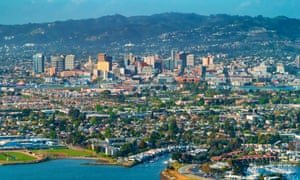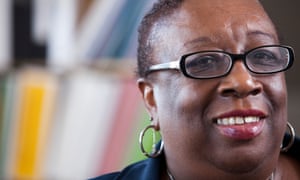For those not directly affected, the ability to breathe more easily and see further has perhaps been the greatest consolation amid the trauma of the coronavirus pandemic.
As city after city begins to emerge from lockdown, urban planners and environmental campaigners are grappling with how to keep the clean air and blue skies that have transformed our view of the world. “Citizens around the world can see change is possible,” says Zoe Chafe, an air quality specialist with the C40 group of global megacities. “Just put yourself on the rooftop and imagine seeing mountains for the first time, and thinking how amazing it feels to realise this is possible.”
That rooftop could be in Kathmandu (where residents were astonished to make out Mount Everest for the first time in decades), Manila (where the Sierra Madre became visible again) or dozens of other cities across the world.
Not everywhere has seen air quality improvements in recent months. In some Asian cities, such as Hanoi and Jakarta, pollution has become worse. But, for the most part, people across the world are experiencing a healthier alternative to the smoke and smog that are responsible for an estimated 3 million deaths a year.
Having seen the shroud lift, there is a growing clamour not to let it fall again. Cities across the world are exploring ways to permanently reduce pollution. Chafe says there is no quick, one-case-fits-all solution, but there are lessons – on environmental justice, community activism, urban design, climate ambition, technological innovation and municipal leadership – that can be learned from the cities and states that were making progress even before the lockdown. Here are three.
Copenhagen
Copenhagen has the world’s most ambitious plan to cut emissions: carbon neutral by 2025. This is pushing the Danish capital to go beyond the existing model of smart, clean urban design and cycle-centred transport that has turned it into one of the cleanest cities in the world.
Grassroots activism, pragmatic government and high taxes have been the drivers for change. Old photographs prove the city had as much of a car culture as any European city in the 1970s, when more than 100,000 citizens demonstrated in Radhuspladsen (City Hall Square) to demand their streets back. Since then, town planners have steadily reduced parking spaces and widened areas for pedestrians and bicycles.
Jeppe Juul, of the Danish Eco Council, says it is a question of priorities. “It feels good to walk around Copenhagen,” he says. “Pedestrians have more space than bikes, and bikes have more space than cars.” The city now vies with Amsterdam for being the most bicycle-friendly city in the world. This means traffic lights with resting bars that riders can hang on to without touching the ground, take-away coffee containers designed for bikes, and groups that organise parent’s shifts for schools runs on “minibus-like” bicycles that can take up to six children at a time.

Copenhagen’s 2025 target depends largely on replacing coal-fired heating with biomass, wind and geothermal energy. A new district-heating infrastructure will allow neighbourhoods to scrap home boilers. Urban planners aim to use carbon capture and storage technology to trap emissions from the main municipal waste incinerator.
Some still doubt the city will be zero-carbon within five years, but Mikkel Krogsgaard Niss, from the mayor’s office, says sceptics have been proved wrong in the past. “From 2014-20, we reduced carbon dioxide by more than 50%, so we are on our way,” he says.
These shifts will create up to 35,000 jobs, with most of the money coming from public coffers. Residents already pay some of the highest rates of tax in the world, but this is seen as an investment in health and quality of life. The city’s wastewater plant was also expensive, but now that it is operational, residents can swim in the harbour – something unthinkable in urban waterways elsewhere. Danes are consistently ranked among the world’s healthiest and happiest people.
The municipality also wants to completely phase out combustion engines by electrifying the bus fleet and banning petrol and diesel cars within five years. After that plan ran into opposition from the national government, local environmental NGOs lobbied for a revolutionary new traffic management scheme that hugely decreases the convenience of car use. The “distribution plan”, which was pioneered in the Belgian town of Ghent, divides the urban centre into a handful of zones and prohibits drivers from going directly from one to another. Instead, they have to go via the suburbs. “It means there is no such thing as a short drive to the bakery or wherever in this system,” says Jens Muller, the air quality manager of the Transport & Environment NGO. As a result, walking, cycling and public transport become more appealing. “It’s the most radical thing you can do apart from creating a no-car zone,” says Juul.
Copenhagen is in a group of European cities, including Amsterdam, Paris, London and Oslo, that are trying to set the global pace for air quality improvements. Muller says London is a leader on ultra-low emission zones, Oslo on promoting use of electric cars, while Paris is exploring radical plans for “a city of 15 minutes” that aims to ensure every resident can get the shops and services they want within a short walk or bicycle ride. Cities in Germany are pioneering pop-up infrastructure and tactical urbanism that allow communities to block roads at certain times for certain events. In Brussels, residents now have a say in when to close roads for children’s parties and barbecues. Muller says this reduces pollution because people spend more time outside their homes.
The foundation, he says, is community activism by previous and current generations. Amsterdam may now be aiming for zero-carbon boats and yet more bikes, but – like Copenhagen – the origins of its strong air-quality ambition was the parents’ movement in the 1970s, which campaigned against the number of road traffic accidents with banners demanding: “Stop murdering our children.” More recently, Madrid has seen a fierce political contest for control of the streets, with 20,000 people rallying last year to oppose plans by the ruling rightwing coalition to reopen the city centre to cars. The “Madrid Central” zone in the Spanish capital had achieved more nitrogen dioxide reductions than any city in Europe. So far, people power has kept the cars out.

California (Oakland and Los Angeles)
The importance of grassroots activism has recently been enshrined into law in California, where campaigners have persuaded the government that if it wants to improve air quality it needs to empower low-income BAME neighbourhoods, which are worst affected because they often live closest to pollution sources.
California has made impressive strides since the 1980s, when Los Angeles, Oakland and San Jose were notorious for a toxic haze that blanketed the city for more than 200 days of the year. These days, thanks to tighter regulations, higher petrol standards and less reliance on coal, there are usually fewer pollutants in the air and about 60 more days of blue skies a year. Several cities have also launched “green new deals”. Even the car capital of the world, Los Angeles, is trying to nudge commuters on to an upgraded public transport system.
But perhaps the most impressive work is being done at the community level by local activists in hotspots of pollution. The leading light in this initiative is Margaret Gordon, who has spent almost 30 years campaigning for environmental health and social justice in her West Oakland neighbourhood, a part of the San Francisco Bay Area that sits between two highways, a busy port, factories and the proposed site of a coal terminal.
She first realised how badly her mostly black and Latino community was affected in 1992 when she started working part-time at a local school where she saw shoeboxes full of asthma inhalers, each with the name tag of a different child. “That was the start,” she recalls in a Zoom chat interrupted by her coughing. “After that, I went to a local meeting to express my righteous outrage about the conditions in the neighbourhood.”
Gordon began monitoring the numbers of trucks that passed through on their way to the port. She later received training and funding to measure levels of fine particulate matter known as PM2.5 that can enter the bloodstream and cause respiratory disease. Even inside her home, the readings were unhealthily high.

She founded the West Oakland Environmental Indicators Project, and worked with scientists, who collected data to prove what she had long believed – that low-income minority communities are far more likely to suffer the ill effects of air pollution (later including higher vulnerability to Covid-19) than other sectors of society.
The pressure has reaped results. The California Air Resources Board ordered the port to take action. There is now stricter regulation of trucks, the port has electrified its facilities and the planned coal terminal has been blocked. Air pollution is 74% lower than in 2008, according to the port. Gordon wants more. “The windowsills have gone from black to grey. But there is still a long way to go. We still have hotspots.”
Her biggest achievement, however, may have been to help draft state law AB617, which passed in 2017 and put local communities at the centre of emissions reductions planning. West Oakland is now one of three Californian neighbourhoods that have drafted their own action plan for dealing with pollution sources. Air quality activists hope this will also address the tendency for wealthy white communities to go low carbon by offloading pollution towards poorer black and Latino areas. Of the two north-south highways in Oakland, it is no coincidence that trucks are banned only on the 580, which passes through a more affluent part of the city. Gordon says the goal is environmental equality.
Mexico City
Among air quality wonks and urban planners, perhaps the greatest buzz of excitement is about Mexico City. The Central American megalopolis was named the world’s most polluted capital in 1992, but it has since managed to improve air quality despite the pressures of an extra 5 million inhabitants.
Today it has perhaps the most environmentally savvy mayor in the world. Claudia Sheinbaum Pardo, the first woman to hold the office, is an energy scientist who won the Nobel peace prize in 2007 for her work on the UN Intergovernmental Panel on Climate Change.
In a previous stint as the director of the city’s environment department, she oversaw the introduction of the Metrobus, a rapid-transit bus with dedicated lanes. Now she is aiming higher. Last year, she announced a six-year environmental plan, including a 30% cut in air pollution, a 40bn-peso (GBP1.5bn) modernisation of the metro and a campaign to plant 15m trees. Her government has banned the use of single-use plastic bags and plans to gradually phase out other single-use items, such as straws, cups and balloons.
The city’s biggest challenge is traffic. Cars must be off the road for part of the week under the city’s widely replicated Hoy No Circula system, which restricts when vehicles can be on the road based on their number plates. But this has had mixed results because wealthier people simply buy more vehicles to get round the restrictions. The number of vehicles almost doubled between 2006 and 2016, and now account for about 70% of emissions and most nitrogen dioxide pollution in the metropolitan area. Previous administrations have lessened the impact by tightening gasoline standards, expanding monitoring and restricting access to the central corridor in the heart of the city.

There are still dreadful smog spikes, particularly when forest fires in the surrounding hills add to exhaust fumes. Last year, the air was so unhealthy that the government closed schools, temporarily banned tens of thousands of cars from the road and forced professional football games to be rescheduled. But, overall, there have been long-term gains. Since 1988, ozone is down 46% and the amount of larger PM10 particles has fallen by 74%, according to Marco Balan, an adviser to the city’s air quality general director. “The view out of my window has improved,” he says. “But we have a long way to go.”
Sheinbaum wants to go further by raising emissions standards for new vehicles, promoting use of hybrid and electric vehicles and investing more in the metro system, cleaner buses, light railways and cable cars so that people no longer have to rely on informal – and often dirty and overcrowded – minivans. Campaigners say a more important step would be to end fuel subsidies. Without that, the cycling scheme, known as EcoBici, will always seem like an afterthought and the Via Verde – a project to plant vertical gardens on the pillars of elevated roads – will inevitably be dismissed as window dressing.
“Mexico City is a stunning example of air quality improvements,” says Chafe. “They are dealing with it in a holistic way. They know they have many sources and realise it has a huge impact on life expectancy and quality of life. The situation is not perfect, but they have made really impressive progress.”
Building on that – here and elsewhere – will be the key after lockdown, she says. “We have seen an improvement in air quality in the past few months. It has been happening for the wrong reasons and in a sad situation. I hope we can now find a way to achieve the same results in a socially fair and feasible way.”